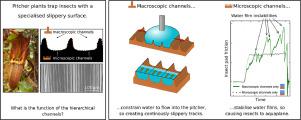Acta Biomaterialia ( IF 9.7 ) Pub Date : 2020-11-12 , DOI: 10.1016/j.actbio.2020.11.005 David Labonte , Adam Robinson , Ulrike Bauer , Walter Federle

|
Nepenthes pitcher plants capture prey with leaves specialised as pitfall traps. Insects are trapped when they ‘aquaplane’ on the pitcher rim (peristome), a surface structured with macroscopic and microscopic radial ridges. What is the functional significance of this hierarchical surface topography? Here, we use insect pad friction measurements, photolithography, wetting experiments and physical modelling to demonstrate that the ridges enhance the trap's efficacy by satisfying two functional demands on prey capture: Macroscopic ridges restrict lateral but enhance radial spreading of water, thereby creating continuous slippery tracks which facilitate prey capture when little water is present. Microscopic ridges, in turn, ensure that the water film between insect pad and peristome remains stable, causing insects to aquaplane. In combination, the hierarchical ridge structure hence renders the peristome wettable, and water films continuous, so avoiding the need for a strongly hydrophilic surface chemistry, which would compromise resistance to desiccation and attract detrimental contamination.
中文翻译:

解开中的猎物捕获机制表面形貌和内在的润湿性的作用猪笼草猪笼草
猪笼草投手植物用专门作为陷阱的叶子捕获猎物。当昆虫在投手边缘(水口)上“滑水板”时,它们被困住了,投手边缘是由宏观和微观径向脊构成的表面。这种分层表面形貌的功能意义是什么?在这里,我们使用昆虫垫摩擦力测量,光刻,润湿实验和物理建模来证明,这些山脊通过满足对猎物的两个功能需求而提高了捕集阱的功效:宏观的山脊限制了横向运动,但增强了水的径向扩散,从而形成了连续的光滑轨道当水很少时,有助于捕获猎物。反过来,微小的脊确保昆虫垫和Peristome之间的水膜保持稳定,从而使昆虫滑水。结合,

























 京公网安备 11010802027423号
京公网安备 11010802027423号